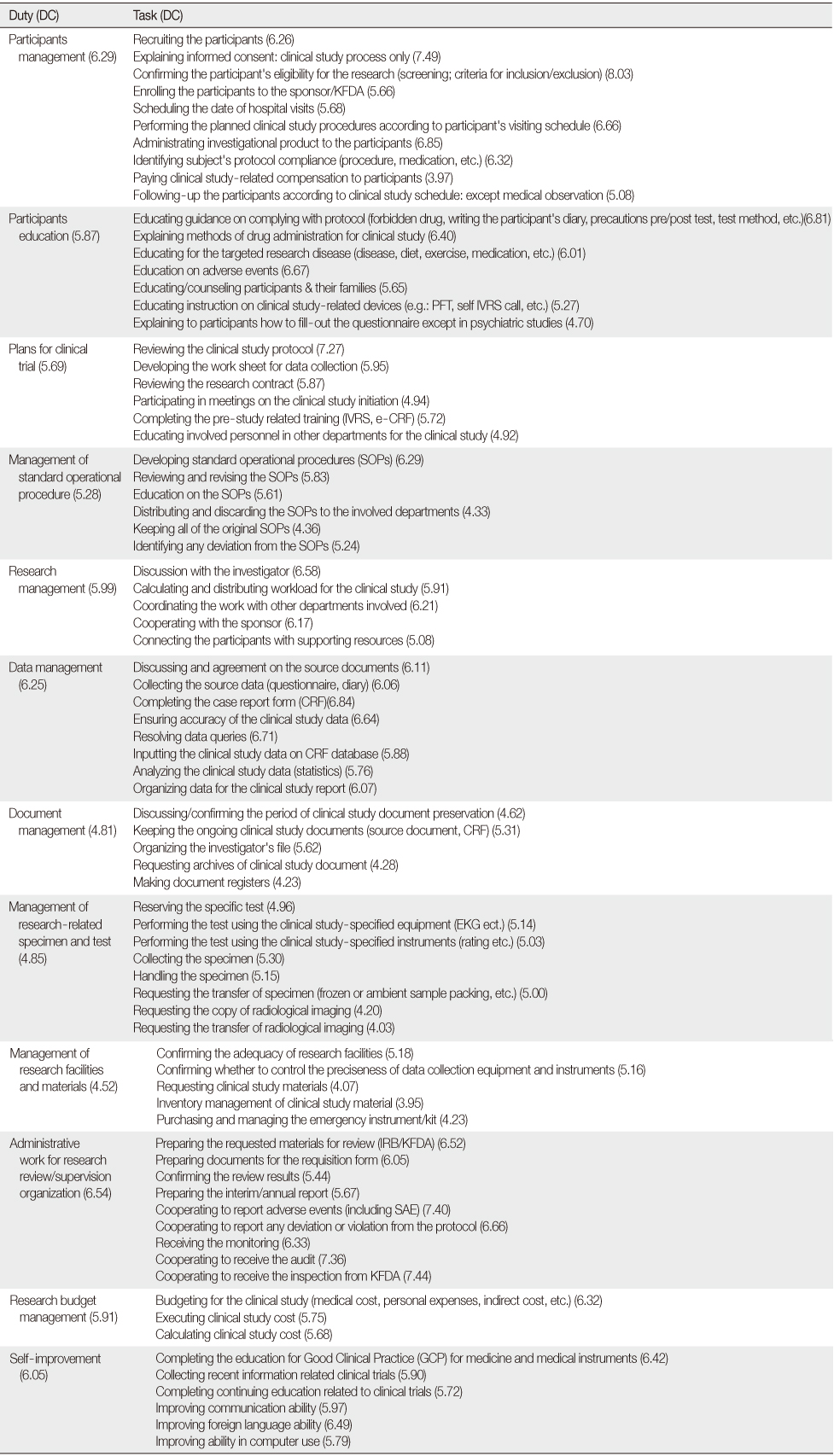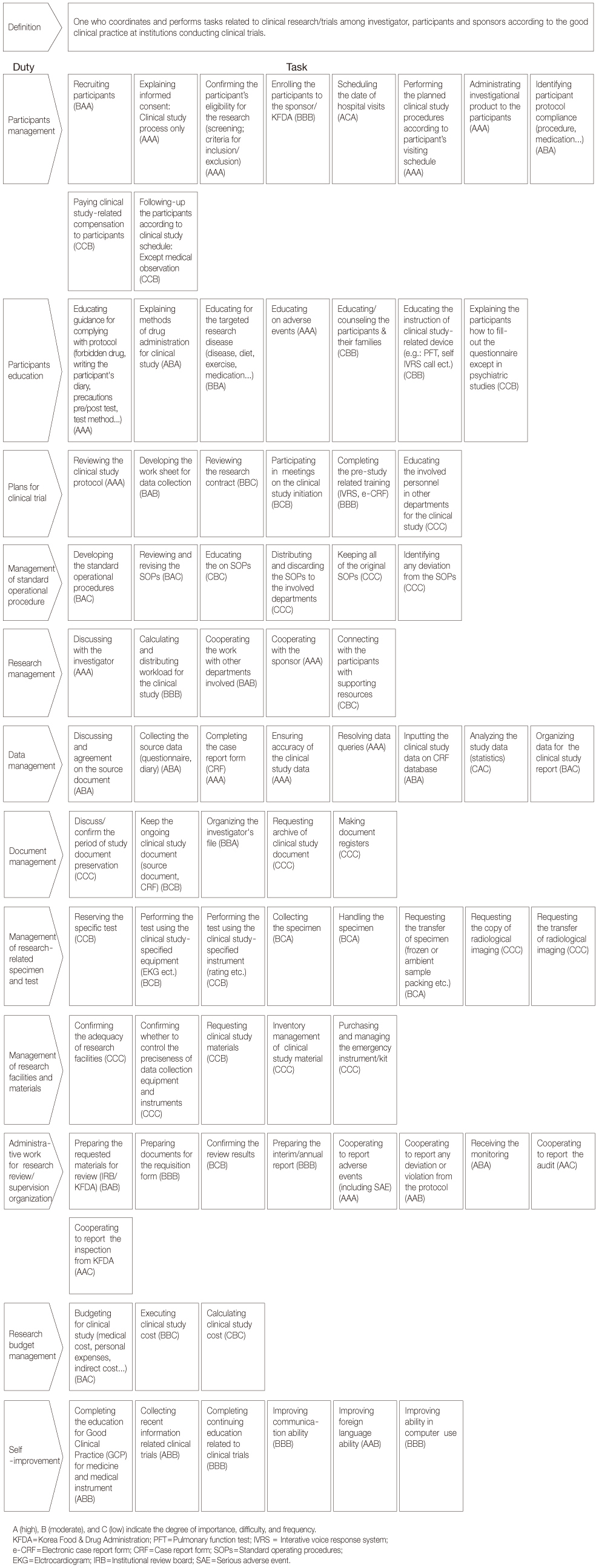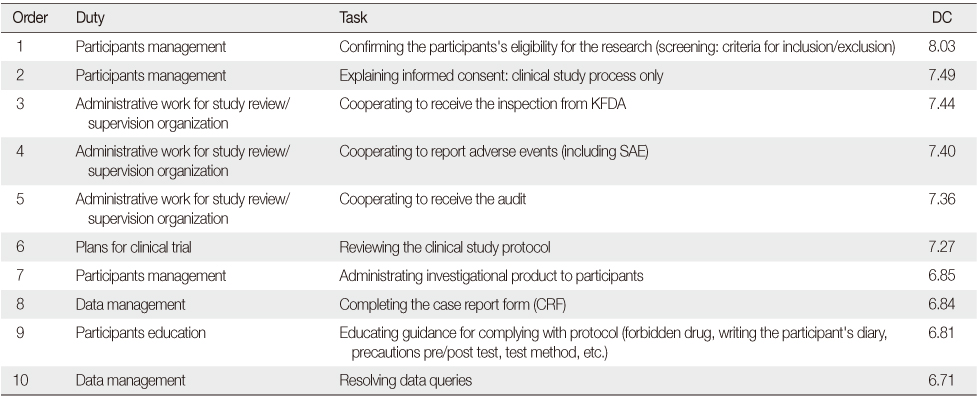Articles
- Page Path
- HOME > J Korean Acad Nurs > Volume 42(7); 2012 > Article
-
Original Article
- Job Analysis of Clinical Research Coordinators Using the DACUM Process
- Hyun-Sook Kang, Haeng-Mi Son, Nan-Young Lim, Kyung-Sook Cho, Sung-Bok Kwon, Yeo-Jin Yi, Young-Sook Park, Eun-Hee Lee, Joo-Hyun Kim, Hye-Ja Han, Jung-Mi Baik, Younhee Jeong
-
Journal of Korean Academy of Nursing 2012;42(7):1027-1038.
DOI: https://doi.org/10.4040/jkan.2012.42.7.1027
Published online: December 31, 2012
1College of Nursing Science, East-West Nursing Research Institute, Kyung Hee University, Seoul, Korea.
2Department of Nursing, University of Ulsan, Ulsan, Korea.
3Department of Nursing, Hanyang University, Seoul, Korea.
4Global Campus, College of Nursing, Gachon University, Sungnam, Korea.
5Department of Nursing, Dongshin University, Naju, Korea.
6College of Nursing, Gachon University, Incheon, Korea.
7College of Nursing, Seoul National University, Seoul, Korea.
8Department of Nursing, Gangneung-Wonju National University, Wonju, Korea.
9Department of Nursing, Kangwon National University, Chuncheon, Korea.
10Department of Nursing, Shinsung University, Dangjin, Korea.
11Clinical Trials Center, Seoul National University Hospital, Seoul, Korea.
- Address reprint requests to: Son, Haeng-Mi. Department of Nursing, University of Ulsan, 93 Daehak-ro, Nam-gu, Ulsan 680-749, Korea. Tel: +82-52-259-1239, Fax: +82-52-259-1236, sonhm@mail.ulsan.ac.kr
© 2012 Korean Society of Nursing Science
- 1,205 Views
- 11 Download
- 13 Crossref
Abstract
-
Purpose
- This study was done to analyze the job of clinical research coordinators (CRCs).
-
Methods
- Through the "developing a curriculum (DACUM)" workshop, the definition of CRCs' role was described and CRCs' duties and tasks were identified. Finally, the developed duties and tasks were validated for importance, difficulty, and frequency.
-
Results
- A CRC is defined as the one who coordinates and performs tasks related to clinical research/trials among investigators, participants, and sponsors according to the Good Clinical Practice at institutions conducting clinical trials. Twelve duties and 78 tasks were identified on the DACUM chart which represented the importance, difficulty, and frequency of tasks represented as A, B, and C respectively. Based on determinant coefficient (DC) of the task, the highest ranked task was confirming the eligibility of participants for research (DC=8.03) and the lowest was inventory management for clinical study materials (3.95).
-
Conclusion
- In this study, the job of a CRC was analyzed through the DACUM process and it was found that CRCs were doing various duties and tasks. Based on these results, it is suggested that it is necessary to develop CRC education programs considering the career ladder of CRCs.
INTRODUCTION
METHODS
1) CRC job analysis using DACUM analyze method
(1) Selection of DACUM committee members
(2) Derivation of CRCs' duties and tasks
2) Validating the results of DACUM job analysis
(1) 1st validation
(2) 2nd validation
3) Preparing CRC task sheet (DACUM chart)
(1) Research instrument
(2) Subjects and data collection
(3) Data analysis
RESULTS
DISCUSSION
CONCLUSION
- 1. Bartlett JE, Kotrlik JW, Higgins CC. Organizational research: Determining appropriate sample size in survey research appropriate sample size in survey research. Inf Technol Learn Perform J. 2001;19(1):43–50.
- 2. Byun SJ, Kim HK, Kim AR, Ha HS, Joen KO. Task analysis of Korean transplantation nurse practitioner. J Korean Acad Nurs. 2003;33:179–188.ArticlePDF
- 3. Cooper D, Aherne M, Pereira J. The competencies required by professional hospice palliative care spiritual care providers. J Palliat Med. 2010;13:869–875. http://dx.doi.org/10.1089/jpm.2009.0429.ArticlePubMed
- 4. Dawson JA, Benson S. Clinical nurse consultants: Defining the role. Clin Nurse Spec. 1997;11:250–254. http://dx.doi.org/10.1097/00002800-199711000-00009.PubMed
- 5. DeOnna J. DACUM: A versatile competency-based framework for staff development. J Nurses Staff Dev. 2002;18:5–11.PubMed
- 6. Hill G, MacArthur J. Professional issues associated with the role of the research nurse. Nurs Stand. 2006;20(39):41–47.Article
- 7. Hwang YS. Job analysis of clinical research nurse in oncology department. 2008;Seoul, Yonsei University. Unpublished Master's thesis.
- 8. Kang HS. Strategies of competitiveness strength for clinical research coordinator thorough their better position and treatment. Paper presented at meeting of the Korea National Enterprise Clinical Trials. 2010;07;Seoul.
- 9. Kang HS, Kim WO, Jeong IS, Baik JM. The working conditions and clinical trial practice of research nurses. Clin Nurs Res. 2004;9:42–55.
- 10. Kang HS, Kim WO, Jeong IS, Choung SY, Shin SG. Developing the infrastructure for clinical trial in Korea. J Korean Soc Clin Pharmacol Ther. 2004;12:147–162.ArticlePDF
- 11. Kim PO. DACUM Handbook. Institute of research in technology education. 2006;Daejeon, Chungnam University Publisher.
- 12. Kim KS, Park YH, Lim NY. Task analysis of the job description of gerontological nurse practitioners based on DACUM. J Korean Acad Nurs. 2008;38:853–865. http://dx.doi.org/10.4040/jkan.2008.38.6.853.ArticlePubMed
- 13. Levine EL, Ash RA, Hall H, Sistrunk F. Evaluation of job analysis methods by experienced job analysts. Acad Manage J. 1983;26:339–348. http://dx.doi.org/10.2307/255981.Article
- 14. Norton RE. DACUM handbook. 1997;2nd ed. Columbus, OH, Ohio State University.
- 15. Norton RE. Competency-based education via the DACUM and SCID process: An overview. 2008;Retrieved Jun 20, 2011. from http://www.unevoc.unesco.org/e-forum/CBE_DACUM_SCID%20article(2).pdf.
- 16. Oh PJ, Kim IO, Kim YH, Shin SR, Lee KS, Han SJ. Task analysis of Korean geriatric care managers. J Korean Acad Nurs. 2006;36:770–781.ArticlePDF
- 17. Oliver JD, Hill RK. The vocational-technical education consortium of states. J Am Assoc Teach Educ Agric. 1974;15(2):4–8.ArticlePDF
- 18. Park MS. Current performance and plan of clinical trials training academy. Paper presented at meeting of the Korea National Enterprise Clinical Trials. 2010;07;Seoul.
- 19. Pelke S, Easa D. The role of the clinical research coordinator in multicenter clinical trials. J Obstet Gynecol Neonatal Nurs. 1997;26:279–285. http://dx.doi.org/10.1111/j.1552-6909.1997.tb02143.x.ArticlePubMed
- 20. Poston RD, Buescher CR. The essential role of the clinical research nurse (CRN). Urol Nurs. 2010;30:55–63. 77. ArticlePubMed
- 21. Raja-Jones H. Role boundaries-research nurse or clinical nurse specialist? A literature review. J Clin Nurs. 2002;11:415–420. http://dx.doi.org/10.1046/j.1365-2702.2002.00597.x.ArticlePubMed
- 22. Rico-Villademoros F, Hernando T, Sanz J, Lopez-Alonso A, Salamanca O, Camps C, et al. The role of the clinical research coordinator- data manager-in oncology clinical trials. BMC Med Res Methodol. 2004;4:6. http://dx.doi.org/10.1186/1471-2288-4-6.PubMedPMC
- 23. Sherrill WW, Keels-Williams F. Mapping competencies for the multiskilled health care professional: An allied health curriculum reform project. J Allied Health. 2005;34:185–191.PubMed
- 24. Shin SJ, Choi KS, Jeong SG, Kim SG, Park HK, Seok JE. A job analysis of care helpers. J Educ Eval Health Prof. 2012;9:2. http://dx.doi.org/10.3352/jeehp.2012.9.2.ArticlePubMedPMCPDF
- 25. Spilsbury K, Petherick E, Cullum N, Nelson A, Nixon J, Mason S. The role and potential contribution of clinical research nurses to clinical trials. J Clin Nurs. 2008;17:549–557. http://dx.doi.org/10.1111/j.1365-2702.2006.01872.x.ArticlePubMed
- 26. Stevenson TL, Hornsby LB, Phillippe HM, Kelley K, McDonough S. A quality improvement course review of advanced pharmacy practice experiences. Am J Pharm Educ. 2011;75:116. http://dx.doi.org/10.5688/ajpe756116.ArticlePubMedPMC
REFERENCES

DC=Determinant coefficient; KFDA=Korea Food & Drug Administration; PFT=Pulmonary function test; IVRS=Interative voice response system;
e-CRF=Electronic case report form; CRF=Case report form; SOPs=Standard operating procedures.
EKG=Elctrocardiogram; IRB=Institutional review board; KFDA=Korea Food & Drug Administration; SAE=Serious adverse event.
Figure & Data
REFERENCES
Citations

- Exploring technical and vocational education and training and its relationship to employment in Nepal: a mixed methods study
Prakash Kumar Paudel, Mahesh Nath Parajuli, Prakash C Bhattarai
Empirical Research in Vocational Education and Training.2025;[Epub] CrossRef - A Comprehensive Job Analysis of Community Pharmacy Preceptors in South Korea: Roles, Responsibilities, and Competency Gaps
JeeMi Lim, MiKyong Shim
Korean Journal of Clinical Pharmacy.2024; 34(4): 252. CrossRef - Nursing core competencies and educational needs in the low- and middle-income country: A cross-sectional study
Seung Hyeon Yang, Hyejin Jeon, Seyoung Kim, Medina Muratbekova, Madina Zhamankulova, Zamira Kurmanalieva, Gulmira Djumalieva, Hyunsook Shin
Nurse Education Today.2024; 143: 106349. CrossRef - Implementation and Effect Evaluation of Situational Leadership II Training in the Sales Department of ZDTQ Pharmaceutical Group
Ying Li, Liu Du, Lang Cheng, John T. Delaney, J. Xu, A. Windapo, M.H.A. Hassan, A. Hajiyev
E3S Web of Conferences.2023; 409: 02003. CrossRef - Occupational competence needs analysis of welder on medium-scaled car body industries in Indonesia
AYW Putra, B S Wijanarka
Journal of Physics: Conference Series.2019; 1273(1): 012054. CrossRef - Development of Performance Indicators for Clinical Research Coordinators Using the Balanced Scorecard in South Korea
Youn Sun Hwang, Tae Wha Lee
Therapeutic Innovation & Regulatory Science.2019; : 216847901987075. CrossRef - A Resource-Based Relative Value for Clinical Research Nurses’ Workload
Sangmi Lee, Ihn Sook Jeong
Therapeutic Innovation & Regulatory Science.2018; 52(3): 313. CrossRef - The Critical Role of the Clinical Research Coordinator for Clinical Trials: A Survey in Oncology
Margherita Cinefra, Celeste Cagnazzo, Laura McMahon, Francesca Arizio, Sara Campora, Roberta Camisa, Giuliana Canzanella, Marianna Contu, Paola Frati, Roberta Sottile, Stefania Gori, Giuseppe Procopio, Oriana Nanni
Medicine Access @ Point of Care.2017;[Epub] CrossRef - Analysis of Workplace Health Education Performed by Occupational Health Managers in Korea
Yeon-Ha Kim, Moon-Hee Jung
Asian Nursing Research.2016; 10(3): 246. CrossRef - Job Analysis of the Nurses Who Work in Customized Visiting Health Care Services using DACUM Technique
Hye Kyung Nam, Kyung Sook Cho
Journal of muscle and joint health.2015; 22(3): 205. CrossRef - Development of a Standardized Job Description for Healthcare Managers of Metabolic Syndrome Management Programs in Korean Community Health Centers
Youngjin Lee, Jina Choo, Jeonghyun Cho, So-Nam Kim, Hye-Eun Lee, Seok-Jun Yoon, GyeongAe Seomun
Asian Nursing Research.2014; 8(1): 57. CrossRef - Job Analysis of Coordinator Working in the Regional Cardiocerebrovascular Center
Kyung-Sook Cho, Sung-Bok Kwon, Kun Sei Lee, Haeng-Mi Son
Journal of muscle and joint health.2014; 21(2): 153. CrossRef - Comparison of the Perceptions between Investigators and Clinical Research Associates in Role Performances of Clinical Research Coordinators
Il-Sun Ko, Youn-Sun Hwang, Ho-Kon Kim
Journal of the Korea Academia-Industrial cooperation Society.2014; 15(8): 5095. CrossRef

Figure 1
Determinant Coefficient Scores for Duties and Tasks
DC=Determinant coefficient; KFDA=Korea Food & Drug Administration; PFT=Pulmonary function test; IVRS=Interative voice response system;
e-CRF=Electronic case report form; CRF=Case report form; SOPs=Standard operating procedures.
EKG=Elctrocardiogram; IRB=Institutional review board; KFDA=Korea Food & Drug Administration; SAE=Serious adverse event.
Determinant Coefficient Scores for the Most Important Tasks
DC=Determinant coefficient; KFDA=Korea Food & Drug Administration; SAE=Serious adverse event.
Determinant Coefficient Scores for the Least Important Tasks
DC=Determinant coefficient; SOPs=Standard operating procedures.
DC=Determinant coefficient; KFDA=Korea Food & Drug Administration; PFT=Pulmonary function test; IVRS=Interative voice response system; e-CRF=Electronic case report form; CRF=Case report form; SOPs=Standard operating procedures. EKG=Elctrocardiogram; IRB=Institutional review board; KFDA=Korea Food & Drug Administration; SAE=Serious adverse event.
DC=Determinant coefficient; KFDA=Korea Food & Drug Administration; SAE=Serious adverse event.
DC=Determinant coefficient; SOPs=Standard operating procedures.
 KSNS
KSNS
 E-SUBMISSION
E-SUBMISSION



 Cite
Cite

